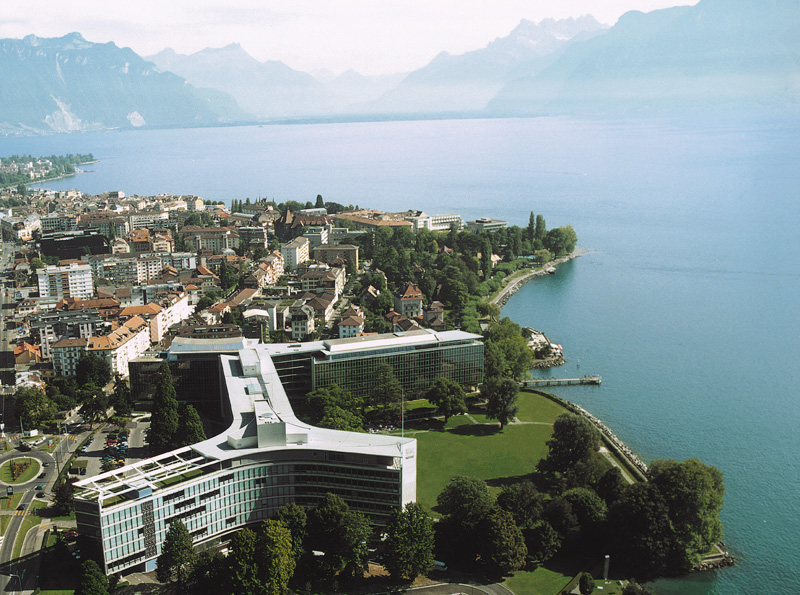|
Zvečevo
Zvečevo is a Croatian food company, specializing in confectionery products and spirits. The company was founded as Stock Cognac Medicinal in 1921 in Požega and produced strong alcoholic drinks. The company was rented to Nestlé from 1936 until 1946, when it also started producing chocolate and candy products. The company changed its name to Zvečevo d.d. Požega in 1951. In the 1960s, all efforts were aimed towards production of cocoa products, strong alcoholic drinks and milk powder, as the unprofitable and outdated production of fruit juices and flour was abandoned. A cooperation with Nestlé was established again in 1970 that lasted until 1995, when it became a joint-stock company. Zvečevo has designed the first rice chocolate in the world in 1964 and named it Mikado. Gallery Trip_to_Croatia-Day_5-Zadar-Chocolat_Croate_Zvecevo_(2240455051).jpg, Mond_kokos_(8553107629).jpg, Mond_kokos_split_(8553107609)_(2).jpg, Super_Sandwich_split_(8265459999).jpg, Super_Sandwich ... [...More Info...] [...Related Items...] OR: [Wikipedia] [Google] [Baidu] |
List Of Companies Of Croatia
Croatia is a sovereign state between Central Europe, Southeast Europe, and the Mediterranean. The service sector dominates Croatia's economy, followed by the industrial sector and agriculture. Tourism is a significant source of revenue during the summer, with Croatia ranked the 18th most popular tourist destination in the world. The state controls a part of the economy, with substantial government expenditure. The European Union is Croatia's most important trading partner. Since 2000, the Croatian government constantly invests in infrastructure, especially transport routes and facilities along the Pan-European corridors. Internal sources produce a significant portion of energy in Croatia; the rest is imported. Croatia provides a universal health care system and free primary and secondary education, while supporting culture through numerous public institutions and corporate investments in media and publishing. For further information on the types of business entities in this cou ... [...More Info...] [...Related Items...] OR: [Wikipedia] [Google] [Baidu] |
List Of Nestlé Brands
This is a dated list of the brands owned by Nestlé globally. Overall, Nestlé owns over 2000 brands in 186 countries. Brands in this list are categorized by their targeted markets. Beverages * Bear Brand * Carnation * Caro (sold in the US as Pero) * Chuckie (Philippines) * D'Onofrio (Peru) * Dancow (Indonesia) * Milo * Nescau (Brazil) * Nesquik * Nestea (joint-venture with Coca-Cola, Beverage Partners Worldwide) * Nesvita (Pakistan, Thailand) * Ovaltine (United States, under license from Associated British Foods) * Ricacao (Ecuador) * Romanette (Switzerland) * Special.T * S.Pellegrino * Sanbittèr (Germany) * Sunar (Czech republic) * Supligen (Caribbean) – milk beverage * Sweet Leaf Tea Coffee * Aguila (Uruguay) * Blue Bottle Coffee Company * Bonka * (Portugal) * Chameleon Cold-Brew *Christina (Portugal) * Dolca (Argentina) * Dolce Gusto * Ecco (Chile, Peru) * El Chaná (Uruguay) * International Roast * Kirma (Peru) * Loumidis (Greece) * Mountain Ble ... [...More Info...] [...Related Items...] OR: [Wikipedia] [Google] [Baidu] |
Croatian Cuisine
Croatian cuisine () is heterogeneous and is known as a cuisine of the regions, since every region of Croatia has its own distinct culinary tradition. Its roots date back to Classical Antiquity, ancient times. The differences in the selection of foodstuffs and forms of cooking are most notable between those in mainland and those in coastal regions. Mainland cuisine is more characterized by Slavic features and influences from the more recent contacts with Turkish cuisine, Turkish, Hungarian cuisine, Hungarian and Austrian cuisine, Austrian cuisine, using lard for cooking, and spices such as black pepper, paprika, and garlic. The coastal region bears the influences of Greek cuisine, Greek and Roman cuisine, Roman cuisine, as well as of the later Mediterranean cuisine, in particular Italian cuisine, Italian (especially Venetian). Coastal cuisines use olive oil, herbs and spices such as rosemary, Salvia officinalis, sage, bay leaf, oregano, marjoram, cinnamon, clove, nutmeg, and lemon a ... [...More Info...] [...Related Items...] OR: [Wikipedia] [Google] [Baidu] |
Požega, Croatia
Požega () is a city in western Slavonia, eastern Croatia, with a total population of 22,364 (census 2021). It is the administrative center of the Požega-Slavonia County. Name Between 1921 and 1991, the town was known as ''Slavonska Požega''. In German language, German, the town is known as ''Poschegg'', in Hungarian language, Hungarian as ''Pozsega'', in Turkish language, Turkish as ''Pojega'', and in Latin language, Latin as ''Incerum'' (-i, n.) and ''Possega''. There is a town in Serbia with same name (see: Požega, Serbia). "Požega" is supposed to be related to the Croatian word "požar", meaning "forest fire". "Incerum" is supposed to come from Proto-Indo-European words *h1eyn (valley) and *kjer (heart), so that it means "the heart of the valley". Geography Požega (elevation: ) is located in the south-western part of the Valley of Požega, or Požega basin, in Croatian: ''Požeška kotlina''. This fertile valley has been important since the antiquity - its Ancient Rome, ... [...More Info...] [...Related Items...] OR: [Wikipedia] [Google] [Baidu] |
Joint-stock Company
A joint-stock company (JSC) is a business entity in which shares of the company's stock can be bought and sold by shareholders. Each shareholder owns company stock in proportion, evidenced by their shares (certificates of ownership). Shareholders are able to transfer their shares to others without any effects to the continued existence of the company. In modern-day corporate law, the existence of a joint-stock company is often synonymous with incorporation (possession of legal personality separate from shareholders) and limited liability (shareholders are liable for the company's debts only to the value of the money they have invested in the company). Therefore, joint-stock companies are commonly known as corporations or limited companies. Some jurisdictions still provide the possibility of registering joint-stock companies without limited liability. In the United Kingdom and in other countries that have adopted its model of company law, they are known as unlimited ... [...More Info...] [...Related Items...] OR: [Wikipedia] [Google] [Baidu] |
Chocolate
Chocolate is a food made from roasted and ground cocoa beans that can be a liquid, solid, or paste, either by itself or to flavoring, flavor other foods. Cocoa beans are the processed seeds of the cacao tree (''Theobroma cacao''); unprocessed, they taste intensely bitter. In making chocolate, these seeds Cocoa bean fermentation, are usually fermented to develop the flavor. They are then dried, cleaned, and roasted. The shell is removed to reveal nibs, which are ground to chocolate liquor: unadulterated chocolate in rough form. The liquor can be processed to separate its two components, cocoa solids and cocoa butter, or shaped and sold as unsweetened baking chocolate. By adding sugar, sweetened chocolates are produced, which can be sold simply as dark chocolate (a.k.a., plain chocolate), or, with the addition of milk, can be made into milk chocolate. Making milk chocolate with cocoa butter and without cocoa solids produces white chocolate. In some chocolates, other ingredients ... [...More Info...] [...Related Items...] OR: [Wikipedia] [Google] [Baidu] |
Drink Companies Of Croatia
A drink or beverage is a liquid intended for human consumption. In addition to their basic function of satisfying thirst, drinks play important roles in human culture. Common types of drinks include plain drinking water, milk, juice, smoothies and soft drinks. Traditionally warm beverages include coffee, tea, and hot chocolate. Caffeinated drinks that contain the stimulant caffeine have a long history. In addition, alcoholic drinks such as wine, beer, and liquor, which contain the drug ethanol, have been part of human culture for more than 8,000 years. Non-alcoholic drinks often signify drinks that would normally contain alcohol, such as beer, wine and cocktails, but are made with a sufficiently low concentration of alcohol by volume. The category includes drinks that have undergone an alcohol removal process such as non-alcoholic beers and de-alcoholized wines. Biology When the human body becomes dehydrated, a person experiences thirst. This craving of fluids results in a ... [...More Info...] [...Related Items...] OR: [Wikipedia] [Google] [Baidu] |
Food And Drink In Italy
Food is any substance consumed by an organism for nutritional support. Food is usually of plant, animal, or fungal origin and contains essential nutrients such as carbohydrates, fats, proteins, vitamins, or minerals. The substance is ingested by an organism and assimilated by the organism's cells to provide energy, maintain life, or stimulate growth. Different species of animals have different feeding behaviours that satisfy the needs of their metabolisms and have evolved to fill a specific ecological niche within specific geographical contexts. Omnivorous humans are highly adaptable and have adapted to obtaining food in many different ecosystems. Humans generally use cooking to prepare food for consumption. The majority of the food energy required is supplied by the industrial food industry, which produces food through intensive agriculture and distributes it through complex food processing and food distribution systems. This system of conventional agriculture relies heavi ... [...More Info...] [...Related Items...] OR: [Wikipedia] [Google] [Baidu] |
Confectionery Companies
Confectionery is the Art (skill), art of making confections, or sweet foods. Confections are items that are rich in sugar and carbohydrates, although exact definitions are difficult. In general, however, confections are divided into two broad and somewhat overlapping categories: baker's confections and sugar confections. Baker's confectionery, also called flour confections, includes principally sweet pastries, cakes, and similar Baking, baked goods. Baker's confectionery excludes everyday Bread, breads, and thus is a subset of products produced by a baker. Sugar confectionery includes candies (also called ''sweets'', short for ''sweetmeats'', in many English-speaking countries), candied nuts, chocolates, chewing gum, bubble gum, pastillage, and other confections that are made primarily of sugar. In some cases, chocolate confections (confections made of chocolate) are treated as a separate category, as are sugar-free versions of sugar confections. The words ''candy'' (Canada ... [...More Info...] [...Related Items...] OR: [Wikipedia] [Google] [Baidu] |






